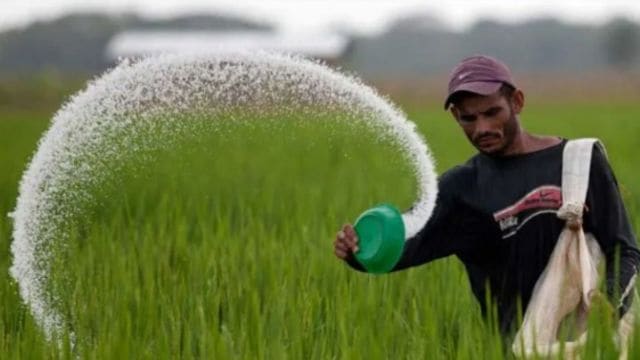Subsidised urea from market is being diverted to industries: farmers
Crackdown exposes ‘industrial misuse’.
 Farmers claimed that the official price of a 45-kg urea bag is Rs 275, but they are "forced to buy a bag at a price as high as three to four times”. (File Photo)
Farmers claimed that the official price of a 45-kg urea bag is Rs 275, but they are "forced to buy a bag at a price as high as three to four times”. (File Photo)Despite officials claiming adequate fertiliser stock in Punjab, farmers in several districts alleged unavailability of subsidised urea, critical for wheat and paddy crops, at authorised outlets. “It is being diverted to industries or used other than farming purposes, leaving cultivators at the mercy of dealers, who exploit farmers by forcing unnecessary purchases,” they alleged.
Farmers claimed that the official price of a 45-kg urea bag is Rs 275, but “we are forced to buy a bag at a price as high as three to four times”.
According to farmers, several dealers “refuse fertilisers supply outright or agree only on the condition, if additional, often non-required, agri-chemical is bought from them”.
“I needed 30 bags of urea. The dealer first flatly refused, but agreed only if I bought other unnecessary farm chemicals worth Rs 700-800 per bag. Hence, I paid Rs 30,000 for what should have cost me Rs 8,250,” said Davinder Singh, Sarpanch of Khabba Rajputan village in Tarn Taran district, who cultivates over 100 acres, including leased land. “This loot must end, and licences of such dealers must be cancelled.”
Davinder said, “Farmers in five-six neighbouring villages are facing the same problem, because the subsidised urea is being diverted for other purposes at higher prices.”
A farmer from Mukerian shared a similar story: “I, too, was forced into buying useless chemicals to get subsidised urea.”
Punjab has more than 25,000 authorised fertiliser and pesticides dealers, including commission agents, and 3,000 cooperative societies officially tasked with distributing fertilisers. Yet, farmers allege “manipulation and diversion of subsidised urea to other sectors”.
Apart from being a vital nitrogen-based fertiliser for crops, urea is also used in resin manufacturing, plywood, adhesives (like Fevicol), cattle feed, and even in some chemical processes. Technical-grade industrial urea is unsubsidised and costs significantly higher than agricultural-grade subsidised urea.
This week only, a major “racket” was busted in Kapurthala district, where a special team led by Chief Agriculture Officer Dr Harkamal Pritpal Singh Bharot raided Satyam Industry in Khati village of Phagwara block and allegedly seized 95 bags of subsidised urea and 135 empty subsidised urea bags. The factory was found “covertly running at night” using generators to “avoid detection and was producing urea-formaldehyde resin,” a component in adhesives, officials said.
A case has been registered against factory owners Manoj Dhingra (Rajasthan) and Mahesh Lal (Haryana) under the Fertiliser Control Order, 1985, and the Essential Commodities Act, 1955.
“Industries are permitted to use only non-technical grade urea. This factory was illegally using subsidised urea meant exclusively for agriculture. Such diversion directly harms farmers,” Dr Bharot said, adding samples have been sent for testing, and the GST intelligence is probing the matter for tax evasion.
The Punjab Agriculture Department, on the other hand, insists “sufficient urea stock is available in the state”.
Farmer bodies argue that raids uncovering “industrial misuse prove fertiliser diversion is rampant, and the government’s distribution monitoring system is failing. “If farmers are being blackmailed into paying extra for essential fertiliser, how can they sustain cultivation costs in a state already burdened by debts?” farmer leader Satnam Singh asked.
Currently, there is no shortage of fertilisers in Punjab.
Dr Gurjit Singh Brar, Joint Director of Agriculture (Inputs), Punjab, confirmed that during the ongoing kharif season, the state’s total requirement stands at 14.50 lakh metric tonnes (LMT) of urea and 2 LMT of Di-ammonium Phosphate (DAP). Against this, Punjab has, so far, received 16 LMT of urea and 2.42 LMT of DAP. Of this, 14.70 LMT of urea and 1.50 LMT of DAP have already been sold, while the remaining stock is available with dealers.
DAP demands generally peak during the sowing of potato and wheat crops in October and November, respectively. Apart from urea and DAP, other fertilisers such as NPK, SSP and MOP are also adequately available. The current stock includes 95,000 tonnes of NPK, 1.5 lakh tonnes of SSP and 47,000 tonnes of MOP, which will be required in the coming months.
“The situation is urgent because in the coming months, vegetable and potato sowing will start, followed by wheat sowing in November. The government must enhance monitoring, cancel licences of dealers indulging in black marketing and ensure every single subsidised urea bag reaches farmers, not the factory,” Davinder said.
As raids and seizures continue, farmers alleged that “the real problem lies in the unholy nexus between dealers and industries, and also lax monitoring, which is turning subsidised urea into yet another tool of exploitation for Punjab’s already distressed farming community”







